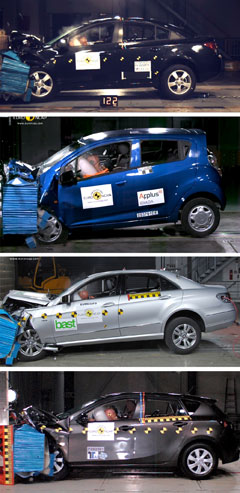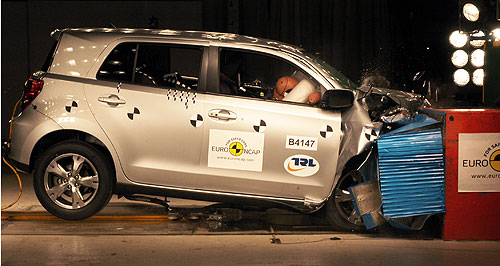Make / Model Search
News - General NewsBrand loyalty under spotlight after crash testsUrban bruiser: Toyota’s Urban Cruiser city SUV managed only 58 per cent for adult occupant protection, despite fitment of a knee airbag. Euro NCAP warns against ‘preconceived ideas’ on brands after mixed crash tests26 Nov 2009 By TERRY MARTIN THE European New Car Assessment Program (Euro NCAP) has handed down maximum five-star overall ratings to no fewer than 10 out of a round of 12 vehicle crash tests, although the two other results – three stars for the Toyota Urban Cruiser and four for the Chevrolet Spark – have prompted a warning for consumers not to be complacent when it comes to brand loyalty. Both the Spark and the Urban Cruiser are under consideration for sale in Australia, with the new-generation Chev compact car – also sold as the Matiz in overseas markets – expected to be rebadged as a Holden and launched here during 2010. The Spark would almost certainly achieve a five-star rating here under the Australasian New Car Assessment Program (ANCAP) were Holden to fit electronic stability control (ESC) as standard. The Urban Cruiser is a sub-RAV4 city SUV that could also make it here during 2010 as Toyota looks to broaden its stable at the bottom end of the market. The Cruiser’s “disappointing” three-star rating came as a result of a “weak” 58 per cent result in the all-important adult occupant protection section, and is well down on the recent five-star result for the iQ sub-light hatch – the other micro-car under consideration for sale in Australia. “The result from Toyota is disappointing, but in 2010 we predict further results like these as Euro NCAP’s next stage of the rating scheme kicks in and requirements become even tougher,” said Euro NCAP secretary general Michiel van Ratingen, referring to a stricter criteria that comes into force from January 1 under a new annual upgrade running until 2012.  From top: Chevrolet Cruze, Chevrolet Spark, Mercedes-Benz E-class, Mazda3. From top: Chevrolet Cruze, Chevrolet Spark, Mercedes-Benz E-class, Mazda3.“Consumers should not make presumptions about a car’s safety performance due to the brand it carries. Given Euro NCAP’s test and assessments continually evolve, consumers must also remember to consider the year of test when looking at results.” Dr van Ratingen underlined this warning with the assertion that recent surveys have shown that one of the top factors influencing a consumer’s choice of vehicle is perception of the reliability of a brand. Euro NCAP welcomed the engineering improvements evident from General Motors, noting the poor one star (with a strikethrough) result for the Chevrolet Aveo – sold here as the Holden Barina – in 2006 and the contrasting five-star result handed down overnight to the all-new Opel/Vauxhall Astra and the Chevrolet/Holden Cruze. The latter received five stars under the ANCAP regime in May, and under Euro NCAP testing achieved an outstanding 96 per cent score in adult occupant protection. Other models to achieve five stars in the latest Euro NCAP testing are the BMW X1, Mazda3, Citroen DS3, Mercedes E-class, Mercedes GLK, Volkswagen Scirocco, Infiniti FX and Peugeot 5008. The Chevrolet Spark came within one point of a five-star rating under Euro NCAP, and would have achieved the accolade if ESC was fitted standard. Undeterred by NCAP’s criticism, Chevrolet Europe described it as a “smashing result”. The Urban Cruiser’s disappointing adult occupant protection performance came despite the presence of a driver’s knee airbag, a device which failed to prevent the crash-test dummy’s left knee making contact with the dashboard and recording high (impact) values. Euro NCAP also noted: “Structures in the dashboard presented a risk of injury to the knees and femurs of both the driver and passenger. In the side pole test, the head curtain airbag failed to prevent a hard contact of the head. “Although only the protection of the head was compromised, under such circumstances Euro NCAP does not award any points for this test as robust airbag performance is considered essential for predictable protection in real-world accidents. “Owing to the unintended airbag performance in the pole test, the same airbag was penalised in the side barrier test, reflected by a lowered score for the driver’s head. “Protection against whiplash injuries in a rear impact was rated as marginal.” Under Euro NCAP’s current rating scheme, car-makers require at least a 25 per cent score in pedestrian protection to be awarded a five-star rating. From 2010, 40 per cent will be required, plus a further five per cent required in adult and child occupant protection to achieve the overall maximum star award. The Cruze was the lowest performer in the pedestrian protection section among the latest models tested, with 34 per cent, with the Citroen DS3 next on 35 per cent. The Peugeot 5008 would also have been missed out on five stars were the testing done in 2010.
 Read more |
Click to shareGeneral News articlesResearch General News Motor industry news |
||||||||||||||||||||||||||||||||||||||||||||||||||||||||||||||||||||||||||||||||||||||||












Facebook Twitter Instagram